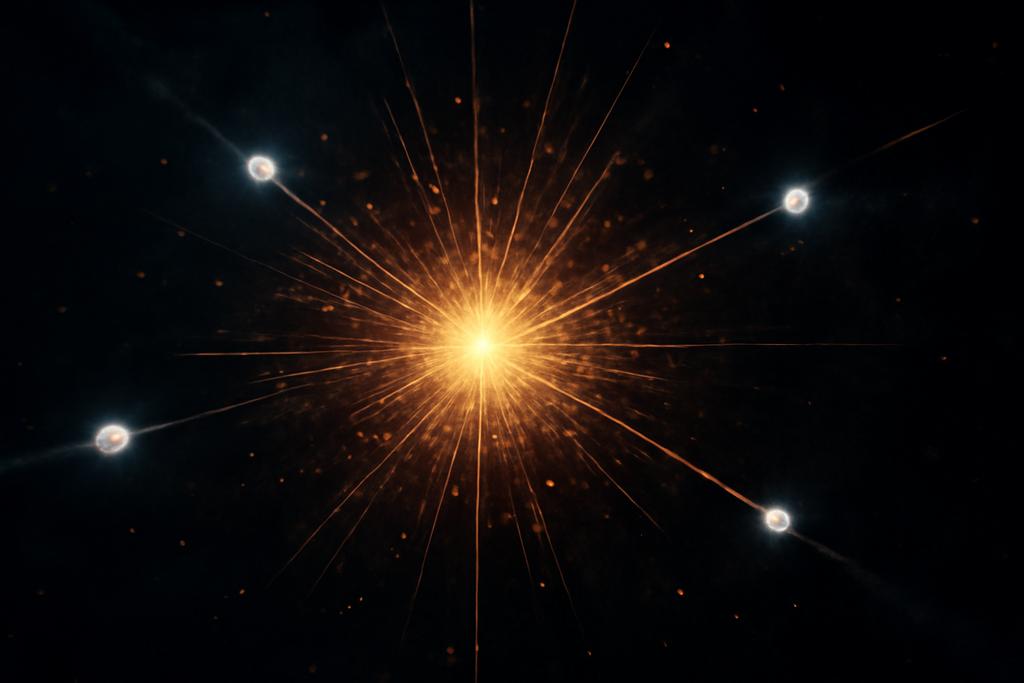The S-matrix is the universe’s most economical diary of how particles gossip with each other. It records every possible collision outcome, but it never tells you the behind‑the‑scenes choreography that makes those outcomes possible. A quiet revolution over the last decade has recast this diary as something more geometric and principled: if you demand unitarity, causality, and locality, the allowed patterns of scattering become surprisingly rigid. The new paper by Justin Berman, Henriette Elvang, and Carolina Figueiredo turns that rigidity into a sharper blade by looking not just at two‑to‑two (4‑point) scattering, but also at what higher-point amplitudes must look like if the world truly respects the same consistency rules. The team writes at the intersection of two huge ideas: higher-point amplitudes obey hidden zeros and special “split” relations, and those extra constraints feed back nonlinearly into the 4-point data that EFTs (effective field theories) actually inhabit. The result is a striking claim: the 4-point landscape, when watched through the lens of 5-point and higher-point splits, isn’t just a convex blob you can slide around. It can fracture into islands, and in a very specific regime it narrows down to the string beta function, a hallmark of how string theory would behave at low energies.
The authors—writing from the Leinweber Center for Theoretical Physics at the University of Michigan, the Niels Bohr International Academy at the Niels Bohr Institute in Copenhagen, and Princeton University—build a bridge from field theory guts to the deeper structure string theory might imprint on amplitudes. The lead researchers, Justin Berman, Henriette Elvang, and Carolina Figueiredo, show that if you require a 5-point amplitude to satisfy hidden-zero and splitting constraints (features already known to hold in Tr(Φ3) theory and some string tree amplitudes), those same conditions force nontrivial, nonlinear relationships among the 4-point Wilson coefficients in the EFT. In other words, higher-point consistency acts like a lock on the door labeled “4-point EFT.” When these nonlinear constraints are included in the S-matrix bootstrap, the pristine convex region you’d expect from simple positivity shrinks into a non-convex shape with sharp corners—one near the celebrated string beta function, another near amplitudes with infinite towers of spinning states at the mass gap.
Hidden zeros and splits
The paper’s central technical idea comes from a geometric way of thinking about amplitudes: hidden zeros are special loci in kinematic space where the amplitude vanishes, yet they aren’t mere accidents. In trees of Tr(Φ3) theory, these zeros correspond to limits where the geometry collapses to a lower‑dimensional object, and near those zeros the amplitude splits into a product of lower‑point amplitudes. The ABHY associahedron—a polytope living in kinematic space—offers a vivid geometric picture: the zeros are where the polytope collapses, and the amplitude around those zeros factorizes in a way that feels almost like a structural wink from the universe, telling you there’s a simpler building block beneath the complexity.
When you translate this idea into the language of EFTs that share the same hidden zeros as Tr(Φ3), you begin with the 4-point amplitude. Its low-energy expansion is written with derivative orders and a family of Wilson coefficients, ak,q, each multiplying a distinct combination of Tr(∂2(k+1)Φ4) operators. The crucial constraint is that the 4-point amplitude must vanish when t = 0 (a hidden-zero condition), which you can enforce by factoring out a −t, yielding an expansion where the content is carried by the ak,q coefficients, with a symmetry ak,q = ak,k−q to ensure crossing symmetry.
The dramatic turn comes when you insist that the 5-point amplitude obey the same hidden-zero structure and, even more, the specific splits that occur when relaxing one hidden-zero constraint. Those splits look like A5 on a particular locus factoring into A4(s12,s15) × A4(s23,s34), and cyclic permutations of such products. What had started as a clean bookkeeping of higher-point residues becomes a source of nonlinear relations among the 4-point coefficients. A striking example appears at the second derivative order: a2,1 must equal 3/2 a2,0 minus 1/2 g2 a2,0,0, tying a seemingly independent 4-point coefficient to others through the cubic coupling g of the Tr(Φ3) sector.
The bootstrap tightens the 4-point map
The S-matrix bootstrap is a method that translates causality and unitarity into powerful mathematical inequalities on low-energy data, typically expressed as dispersion relations for coefficients that survive at low energy. In this study, the authors recast the 4-point EFT amplitude in terms of ck,q coefficients, which admit clean dispersive representations and positivity constraints tied to partial waves. The upshot is intuitive: if you only demand positivity and standard crossing symmetry, the allowed region of coefficients is a convex, well‑behaved region—an EFT‑hedron, if you will. The energy is low, the spectrum above the mass gap is treated softly, and unitarity is simply the statement that spectral densities are nonnegative. This is the bread-and-butter of many EFT bootstrap programs.
But the moment you fold in the nonlinear constraints that come from the 5-point splits, the geometry changes. Those nonlinear relations among ak,q, derived from the requirement that the 5-point amplitude splits in the same way as the 4-point data, cannot be written as simple positive semidefinite matrices. To input them into the numerical bootstrap, the authors linearize the nonlinearities by introducing two dimensionless ratios, X and Y, built from the leading 4-point coefficients: X = a1,0 / a0,0 and Y = (3a2,0 − 2a2,1)/a0,0. With these substitutions, the k = 3, 4, 5, 6 nonlinear constraints become linear equations in X and Y (when you fix g2 in terms of a0,0, a2,0, a2,1, you can eliminate the cubic coupling from higher constraints). You then do the practical, numerically delicate job of scanning X and Y and solving for the remaining coefficients consistent with dispersion relations and null constraints.
The result is a qualitative shift. The familiar convex “EFT‑hedron” becomes a non-convex region once you include the 5-point splits. The authors illustrate this with a clear mental image: before the splits, you could combine two admissible 4-point amplitudes to get another admissible one; after imposing the higher-point splits, that straightforward superposition is no longer guaranteed. The new allowed region has a rugged, angular shape with sharp corners. In particular, there are two notable corners—the string beta function amplitude sits near one, and a hypothetical infinite spin tower amplitude sits near the other. This non-convexity is not a cosmetic feature; it signals that higher-point consistency imposes genuinely nontrivial, nonlinear constraints on the 4-point data, beyond what simple positivity alone would dictate.
Non-convex islands and the spectrum
One of the paper’s most striking moves is to couple the bootstrap to a spectral assumption: there is a finite number of states at the mass gap, Mgap, and then the rest of the spectrum lives above a cutoff µc Mgap. With this spectrum input, the non-convex region splits into two distinct regions: a trivial region corresponding to theories with no states at the mass gap, and a separate island that hugs the string beta function amplitude. In other words, when you insist that there are only a small, finite set of low-mass states, the bootstrap doesn’t just carve away some possibilities; it carves out a precise, tiny island around the string’s 4-point coefficients. The island tightens as you crank up kmax, the order to which you enforce higher-point nonlinear constraints, and as you include more of the nonlinear relations from higher derivatives.
The authors showcase two concrete cases. In ten dimensions with a string‑inspired spectrum cut µc = 2, the island around the string beta function becomes visibly thinner as kmax increases, and the lower boundary of the allowed region slides toward the string’s exact coefficients a1,0, a2,0, a2,1, a3,0, etc. In four dimensions with a tighter cutoff µc = 1.2, the island is larger at modest kmax but still recedes toward the string values as more nonlinear constraints are included. A consistent pattern emerges: when you rule out an infinite tower of spinning states perched right at the mass gap, the string amplitude emerges as the unique, unitary solution compatible with hidden zeros and the five-point splits. That’s a remarkable upshot—the higher-point data is doing something that once seemed the exclusive domain of full UV completions like string theory.
What this means for physics and the road ahead
What makes this result exciting is less about a single numerical corner and more about a broader methodological shift. It’s a concrete demonstration that higher-point information can dramatically sharpen the 4-point EFT story. The beta function amplitude from string theory—famously encapsulated by A4[1234] ∝ Γ(−α′s)Γ(−α′u)/Γ(−α′(s+u)) in a particular normalization—doesn’t just sit near a corner of the EFT space by accident. Under the hidden zeros and splits, the bootstrap nudges the allowed region so that the string amplitude becomes not just a plausible option but, under reasonable spectrum assumptions, the unique option. If this holds more generally, higher-point constraints could become a powerful, intrinsic sieve that filters EFTs in ways that were previously inaccessible by 4-point analysis alone.
One subtle but important point is that this uniqueness is robust against the inclusion of certain higher-derivative details. The nonlinear split relations enforce a set of algebraic relations among ak,q that tightly constrain the even- and odd-derivative sectors, and they produce a factorization structure in the 4-point amplitude reminiscent of, yet distinct from, the familiar monodromy relations that have been used to carve out string-like behavior in past bootstrap programs. The authors show that the 4-point amplitude can be written as a factor times a fully symmetric polynomial in s, t, and u, with the polynomial built from the even- and odd-derivative coefficients in a way that mirrors, but does not trivially reproduce, string theory’s α′ expansion. The upshot is evocative: the theory-space hammering of higher points may reveal a universality that string theory already hints at from its own internal consistency, even when we don’t bake in string-y constraints like monodromy by hand.
Of course, this is a careful numerical and conceptual study with its own caveats. The analysis rests on a weak-coupling regime, a mass gap with a controlled spectrum, and a particular assumption about Regge behavior. The authors discuss how relaxing Regge bounds changes the sharpness of the islands and how more ambitious search techniques (like “Skydiving” in bootstrap language) might help confirm whether the string island truly pinches off into a unique point in all reasonable regimes. They also note that their method can be extended beyond scalars to spinning theories, gauge theories, and other kinds of Goldstone-mode EFTs. The broader message is clear: higher-point structure is not an afterthought; it’s a structural feature that can feed back into and enrich what we learn from the 4-point EFT dreamscape.
So where does this leave us in the grand quest to understand the UV underpinnings of our world? It nudges us toward a hopeful intuition: string theory isn’t just a high-energy handshake; it might be etched into the very way higher-point amplitudes constrain what low-energy physics can be. The work doesn’t prove that every UV completion must be stringy, but it makes a compelling case that, at least in a carefully defined corner of theory space, stringy consistency conditions are not only compatible with, but essential to, the allowed 4-point EFT data when higher-point information is respected. If this program continues to bear fruit, we might one day see a landscape of EFTs that bears a fingerprint: a tiny, string‑shaped island carved out by nonlinear logic that comes alive only when you look beyond the 4-point horizon.
As the authors themselves emphasize, this is a prototype: the method could be extended to supersymmetric theories, to pions and gluons, and to more elaborate S-matrix bootstrap frameworks. The extraordinary thing is not just the numerical islands but the philosophical one: higher-point amplitudes carry a kind of “surfaceology” of quantum consistency, a set of constraints that percolate down to the simplest scattering you can write. In a universe that loves to keep secrets until you ask the right questions, looking at fifth, sixth, and seventh-point amplitudes might be exactly the way to listen for the music underlying the melody we hear in 4-point scatterings. The story in this paper is a bold invitation to keep listening—and to expect surprises in the shape of non-convex islands, hidden zeros, and perhaps a more intimate tie between the open world of EFTs and the stringy cosmos that many of us suspect lies just beyond the horizon.








